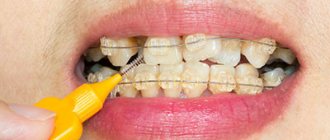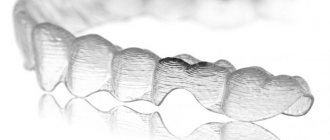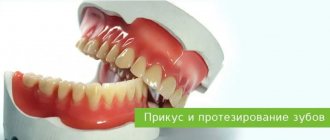There are special requirements for materials used in medicine. An oral denture is a foreign body that the body seeks to reject. Digestion of food begins here, which means that saliva is an aggressive liquid, under its influence even the teeth’s own enamel is destroyed. Chewing is accompanied by repeated pressure on the plane with a force of up to 100 kg/cm2. The denture should not release toxins or interfere with the sense of taste. The surface color, shape and volume remain unchanged for a long time.
Photopolymers in dentistry
Photopolymer for teeth - what is it and how exactly is it used in dentistry? This is a high-molecular compound that has the property of transitioning from a liquid to a solid state under the influence of ultraviolet radiation. The material was invented in the late 70s of the last century by employees of the American company Dart Industries Inc.
Photopolymer resins are intended for the manufacture of dentures; they are completely safe for medical use. With their help, 3D models are created at high speed. They are also used for filling teeth, allowing them to significantly improve their appearance.
Photopolymers have the following qualities: strength, durability, aesthetic appeal. A variety of shades allows you to choose the most suitable filling color. When choosing a material, you should focus on its optical, mechanical and physicochemical characteristics. These parameters are needed to adapt photopolymer resins for 3D printers.
Classification of photopolymer materials by level of filling (or by the ratio of filler and matrix)
- Macro-filled (filler content – 75-80%, particle size – from 5 to 100 microns).
- Microfilled (filler content – 40-70%, particle size – from 1 to 10 microns).
- Nanocomposites (filler content – 30-60%, particle size – from 0.0007 to 0.04 microns).
Different types of materials are used to restore different groups of teeth.
The Print Dent online store offers a wide range of high-quality photopolymer resins from well-known manufacturers: Detax. The products are intended for wide use in dental practice. The online store has a registration certificate that allows the use of materials for 3D printing in medicine.
Variety of photopolymer resins in the catalog:
- Dental Yellow/Clear – has hypoallergenic properties, used after finishing polymerization;
- Dental Sand – used for making temporary dental structures;
- Freeprint cast is a light-curing polymer for the generative production of objects using precision casting technology;
- Freeprint model UV – used for the manufacture of dental models, has maximum hardness and shape stability;
- Freeprint splint is a biocompatible photopolymer intended for the generative production of drilling templates for implantology, X-ray templates and bite splints.
Plastic Safety Standards
For all types of prosthetics, special composite compounds are used, approved after many years of testing. The use of polymers is regulated by GOST 31574-2012. Its requirements correspond to international ones - ISO 4049:1988 for filling materials and ISO 10477:1992 selection of materials for bridges or crowns. The determining indicators of the reliability of orthopedic compositions are the following:
- strength;
- hardness;
- elasticity:
- viscosity;
- plastic;
- fluidity.
Chemical composition of photopolymers, contraindications to their use
The materials consist of various combinations of long and short monomers, oligomers, photoinitiators and additives. Various formulas can be created with a wide range of properties: transparent or colored polymers, flexible or rigid, viscous or heat-resistant.
Characteristics of the main components:
- oligomers and monomers – are the basis of the polymer and form a solid;
- photoinitiators - molecules that react to ultraviolet radiation and initiate a reaction;
- additives – visual and functional additions (pigments, inks, etc.).
Contraindications for the use of photopolymers
- Allergic reactions to individual components.
- Increased occlusal load.
- High degree of dental caries damage.
- The presence of inflammatory processes in the root.
- Poor oral hygiene.
- A tooth can only be restored with a crown.
Dental polymers for the clinic
Before removing a diseased tooth, it is treated for a long time, trying to save it. Filling compounds, corrective onlays, and veneers are used here. It has been experimentally established that copolymer polymers are better suited than other materials for tooth repair at any stage of caries. The seal is subject to harsh operating conditions:
- bears an equal load with natural biomaterial, while being a foreign body.
- The filling is exposed to the surrounding, humid-aggressive environment.
- The destruction of the material occurs under the combined factors, the filling falls out, which indicates low adhesion between the filling material and the bone tissue.
Studies have shown that the initial copolymer methyl methacrylate had weak adhesion and a high coefficient of thermal expansion. The new material included epoxy resins. The resulting putties were devoid of the listed disadvantages, but hardened for a long time. Positive properties were combined by the synthesis of epoxy-methacrylic copolymers. This filling material suited to practitioners is known as Bis-GMA or acrylic oxide. With its advent, it became possible to eliminate chips on the enamel and form a cutter on the pin. The addition of fillers made it possible to obtain a paste-like composition without the release of volatile toxins. Dentists consider nanocomposites to be the best material for dental treatment. One of them is a compomer - a universal composite of monomer, polyacrylic acid and resin, plus amine and benzoyl peroxide. The composition is glass ionomer cement, homogeneous, durable, and is installed on chewing teeth.
Fixed decorative microprostheses
Irregularities and defects of teeth in the smile area can be corrected. Long-term treatment or quick adjustments are possible with the help of special dental plates - veneers. Anyone can flash a white-toothed smile. Each such component is a separate microprosthesis that veneers the tooth.
Mechanism of adhesion of composites to dentin
To obtain a strong adhesion, the following technique is used:
- Treatment of dentin with acid.
- Primer treatment.
- Application of hydrophobic adhesive.
- Insulation.
- Traditional cavity preparation.
- Treatment with 70% alcohol and ether.
- Gasket application.
- Application of etching gel.
- Application of a two-component hydrophobic adhesive.
- Filling the cavity.
- Final treatment of the cavity.
Requirements that must be observed when working with photopolymer
- The ultraviolet light source must be checked periodically, since if its physical properties deteriorate, the quality of the photopolymer will decrease.
- The carious cavity should be filled in layers, this will promote more complete polymerization.
- To prevent premature curing of the photopolymer, it must be protected from extraneous light sources during operation.
- To compensate for shrinkage, directional polymerization techniques should be used.
Good to know. It is necessary to limit the access of unauthorized persons and animals to photopolymer resins.
You can purchase 3D printers for dentistry in the Print Dent online store. These devices are used in dental offices and dental laboratories for the production of crowns, bridges, frames for casting and pressing ceramics, and other dental models. The 3D printers Asiga MAX (have high productivity with minimal dimensions) and Asiga PRO2 62 (designed for the production of large volumes of dental models and high-precision burnable and temporary orthopedic structures) are very popular among clients.
Mechanism of adhesion of composites to enamel
To achieve the required adhesion, the following technique is used:
- A bevel of 45° or more is formed, this will increase the active adhesion surface of the enamel and composite.
- The enamel is etched with 30% phosphoric acid for 15-60 seconds. As a result, organic plaque is removed, micro-roughness of the enamel is formed, and the marginal permeability at the enamel-photopolymer interface is reduced.
- Polymerization is carried out using enamel (hydrophobic) bonds based on the BIS-GMA monomer. Then processes are formed that will provide micromechanical adhesion of the enamel to the bond.
- An adhesive system is used.
- The tooth is filled.
- Final processing is underway.
3D scanning technology is actively gaining popularity in dentistry. The use of 3D scanners can significantly reduce costs in dental production, increase treatment efficiency and business profitability. Managers of the Print Dent online store will help customers select equipment taking into account their tasks.
Dental composite materials (composites)
Dental composites today are the main class of restorative (filling) material. The advantages of composites over many other filling materials are their high strength, which allows them to be used in any clinical situations (both on anterior and chewing teeth); high and flexible aesthetic characteristics that allow you to manipulate the color of restorations and their gloss over a wide range of values; high technology when performing restorations; minimal polymerization shrinkage.
However, composites, even with the maximum content of inorganic filler, still have some shrinkage during curing, a fairly high coefficient of thermal expansion and less rigidity than that of dental tissues. These disadvantages of composites contribute to the appearance of marginal gaps between the filling and the dental surface, leakage of oral fluids through these gaps and, as a result, depressurization of the cavity. This leads either to the loss of the filling (damage to the restoration) or to the development of secondary caries. The disadvantages of composites are eliminated by the use of adhesives (adhesive systems ensure “gluing” of the composite to dental tissue) or other techniques. Therefore, polymerization shrinkage of dental composites is currently not a problem in restorative dentistry.
By definition, a composite material is a mixture of several dissimilar components. In the case of dental composites, it is a mixture of filler (usually inorganic) and an organic matrix, and the filler content is very significant (at least 30% by volume; with a lower filler content, the material is usually classified as a “low-filled polymer”).
Additional components of the organic matrix (in the initial state) are a polymer inhibitor (to increase the curing time and shelf life of the material), a catalyst (in the case of chemically cured composites; a separate component in the form of a paste or liquid), a photoinitiator (in the case of light-cured composites), an accelerator polymerization (in chemically cured composites), ultraviolet light absorber (to improve light stability) and dyes.
Typical fillers for dental composites are amorphous silica, quartz, barium glass, strontium glass, zirconium silicate, titanium silicate, oxides and salts of other heavy metals, and polymer particles. Modern technologies for the production and introduction of fillers include: improved grinding technologies to produce smaller particles; technologies for producing chemically deposited filler particles (the so-called sol-gel process; allows you to obtain filler hybrids); strengthening of composites with fibers (reinforcement; but this leads to a decrease in the transparency of the composite); introduction of porous (chemically deposited) fillers and three-dimensional structures (to reduce shrinkage stress); introduction of fillers with anti-caries properties (primarily those that release fluoride; however, the limitation is the low permeability of the organic matrix of the composite); technologies for modifying the surface of filler particles to allow copolymerization with an organic matrix (for example, alkoxysilanes); nanotechnology.
The size and amount of filler are the basis of the most common classification of dental composites. Based on the size of filler particles, composites are distinguished: macrofilled, macrophiles (10-100 microns); midin-filled (1-10 microns); mini-filled (0.1-1 microns) micro-filled, microphiles (0.01-0.1 microns); hybrid (contain macro- and microparticles); heterogeneous (conventional or hybrid composites with additives of particles of polymer material 1-20 microns in size).
Based on the content of filler particles (the degree of filling of the dental composite), highly filled composites (more than 60% by volume), medium-filled composites (40-60% by volume) and lightly filled composites (30-40% by volume) are distinguished. The polishability, abrasion resistance and color stability of the dental composite depend on the size of the filler particles. Strength, degree of thermal expansion and polymerization shrinkage depend on the degree of filling.
Recently, so-called nanocomposites have been identified among dental composites, which can be conditionally considered as hybrid microphilic (microhybrid) materials. In nanocomposites, “nanosized” particles (nanomers), which have a size of up to 0.1 μm (100 nm), are used as fillers. Nanomers tend to aggregate to form nanoclusters, so in reality a nanocomposite contains a mixture of nanomers and nanoclusters as a filler. Nanoclusters behave like individual particles, and modern technologies make it possible to control their size and shape. As a result of combining nanometers and nanoclusters in one material, the material has a high fullness (more than 75%), which ensures high strength. In conventional hybrid dental composites, during the process of abrasion, strong filler particles leave the surface and leave behind “craters,” which reduces the shine of the restoration or filling. In the case of abrasion of nanocomposites, nanoclusters are removed not entirely, but their smaller components, which allows the nanocomposite to have a more durable shine and good polishability. Nanocomposites of the latest generations (for example, Estet-X) contain three filler phases: nanoparticles, midiparticles phase and miniparticles phase. The ratio of the three phases is strictly dosed. The name “micromatrix” has been proposed for such nanocomposites.
The basis of the organic matrix of dental composites (before the stage of their curing) are monomers, the molecules of which contain fragments of epoxy resin and two methacrylate groups. It is known that methacrylic acid and its derivatives easily enter into polymerization reactions (for example, with the formation of polymethyl methacrylate, which is usually called “plexiglass”), and the reaction proceeds by a free radical mechanism. The first monomer of this type was patented back in 1959 (GMA monomer) and since then GMA and its derivatives have been included in almost all modern dental composites and adhesives. The reason for the dominance of monomers of this type is the relatively low polymerization shrinkage (about 6% in pure form), rapid curing, low volatility, and good mechanical characteristics of the final polymer.
Polymerization initiators are substances that generate free radicals when exposed to light or chemically. Therefore, according to the polymerization (curing) method, dental composites are divided into light-curing composites (light-composites, photo-composites, gel-composites) and chemical-curing composites (self-curing).
Chemically cured dental composites are either paste-paste or powder-liquid systems. The reaction that initiates polymerization (curing) is the interaction (after mixing the starting components) of the amine and benzoyl peroxide with the formation of free radicals. The rate of polymerization depends on the number of initiators, temperature and the presence of inhibitors. The main advantage of such dental composites is uniform curing, regardless of cavity depth and filling size.
Light-curing dental composites are a one-component initial form (paste or flowable material). A light-absorbing substance (photoinitiator; the most traditional is camphoroquinine, maximum absorption spectrum is 475 nm), which, when absorbing light with a wavelength of 400-500 nm (blue light), forms free radicals, is used as an initiator of polymerization (curing). Light composites do not require mixing (therefore they are more homogeneous), they allow modeling of the restoration (filling) before light curing, and the absence of chemically active additives (the absence of amines) gives them color stability and aesthetics. However, it should be taken into account that the degree and depth of polymerization may be non-uniform and depends, first of all, on the transparency and color of the composite, and the power of the light source. Typically, layer-by-layer application and curing of the dental composite is carried out, which makes it possible to reduce shrinkage and stress in the matrix and more accurately select the color of the restoration (filling).
The light source for curing dental composites is usually conventional halogen lamps (halogen photopolymerizers). Their disadvantages are the small “useful” component of radiation (less than 2%), the need to use an interference filter that cuts off stray thermal radiation, and a fan (to remove heat). Recently, emitting LEDs are increasingly used as light sources, the emission spectrum of which practically coincides with the absorption spectrum of camphoroquinone, and which do not have all the disadvantages of halogen lamps.
A separate group of dental composites with which teeth are filled are restoration (filling) materials of a “hybrid” type – compomers.
Compomers are light-curing restoration (filling) materials that combine the main advantages of composites (ease of use, strength, aesthetic properties) and glass ionomer cements (chemical adhesion to tooth tissue, good biocompatibility, fluoride release). The term “compomer” comes from a combination of the words COMPOSITE and glass ionomer. The initial (before polymerization) organic matrix of compomers is a monomer (acid methacrylate), the molecule of which contains methacrylate (like a composite) and acid (like glass ionomer cement) groups. Compomer fillers are fluoroalumosilicate glass particles. Acid methacrylates can simultaneously cure by the free radical mechanism (as in the case of polymerization of light-curing composites) and by the ion exchange mechanism (as in the case of glass ionomer cements). Curing of compomers occurs only due to light-induced polymerization. Curing similar to glass ionomer cements (requiring the presence of water to dissociate acid groups) occurs only in areas of the material in contact with water.
Compomers differ from classical hybrid glass ionomer cements modified (reinforced) with composites. In the latter, the ion exchange reaction, which initiates the curing of the material, is the dominant part of the entire curing process. In contrast, compomers are materials that contain the main components of glass ionomer cements in quantities insufficient to maintain the ion exchange reaction under normal (anhydrous) conditions. Although compomers were developed to combine the best properties of resin composites and glass ionomer cements, their behavior is more similar to that of dental composites.
Disregarding the basic physical and chemical characteristics of materials, the entire range of modern dental composites, according to the features of their application, can be divided into 5 main groups.
- Universal composites with one-color color restoration concept. This group includes almost all chemically cured composites and some light-cured composites.
Charisma PPF. Chemically cured composite material. Used for filling, restoration of the crown part of the tooth, fixation of mobile teeth.
Ceram X. Light-curing nanocomposite for small restorations (fillings) of chewing teeth. The material has been optimized for highly aesthetic restorations with a minimum number of shades.
- Versatile composites with a two-layer color reproduction concept. Such composites (restorative systems) include one or more dentins, which provide the creation of the internal structure of the tooth, and a set of enamel shades (including a transparent cutting edge), which ensures the refraction of light on the tooth surface. These materials make it possible to achieve fairly high results in the restoration of anterior and chewing teeth, but still somewhat limit the creative possibilities of the dentist in reproducing color.
Filtek Z 250 (Filtek Z 250). Aesthetic light-curing microhybrid composite. Contains an increased amount of smaller particles. It is used for filling cavities of all types in the frontal and chewing teeth, making veneers, restoring the coronal part of the tooth, and splinting. Has 15 different shades.
Spectrum TPH. Light-curing microhybrid composite. The filler (barium glass and sintered silicon) has 2 fractions of 0.04-0.4 microns and 0.8-1 microns with a filling of 55-60% by volume. Due to the successful combination of aesthetic and mechanical properties, they are used for restoration (filling) of all types of defects in hard dental tissues. An entire generation of dentists grew up on this material and mastered the basics of cosmetic restoration techniques.
- Restoration materials with a three-layer color reproduction concept. Restoration (filling) materials of this group are “artistic” systems. The range of shades includes a wide range of opane (opaque) dentin shades, basic tooth body shades and a set of transparent enamels.
Estet-X. Light-curing micromatrix composite material. The filler is presented in the form of three phases (up to 2.5 microns, 0.4-0.8 microns and nanoparticles 0.01-0.02 microns), the ratio of which is strictly dosed. Has extremely high aesthetic capabilities. Used by dentists who focus primarily on achieving high aesthetic results. With the same strength and color stability as, for example, Spectrum TRN, it is washed 3 times less, does not require updating the gloss and has 2 times less shrinkage (which justifies the high cost of this material).
Filtek Supreme. Light-curing nanocomposite material. The filler (zirconium silicate) is presented in the form of nanoparticles (0.02-0.75 microns in size) and nanoclusters. The technology allows you to control the size of nanoclusters (create a given size) and in this way influence the strength, polishability and polymerization shrinkage of the material. A universal restoration (filling) material that combines the mechanical properties of microhybrids and the aesthetics of microfills.
The choice of a dentist in favor of a specific material from these three groups is associated with a combination of several factors (price of the material, cost of work, time spent working with the patient and the qualifications of the doctor, the final aesthetic result). For relatively simple restoration (filling), dental composites of the 1st and 2nd groups are predominantly used. If the dentist is not very limited in time, and his patient is less limited in funds, he can use materials of the 3rd group, which provide him with wider opportunities.
- Dental composite materials for restoration (filling) of chewing teeth. The main requirements are high resistance to abrasion and deformation under chewing load.
Quixfil. A light-curing composite material designed specifically for restoration (filling) of chewing teeth. It has a high (30% greater than most other composites) fullness, due to which it has increased hardness and low polymerization shrinkage. The filler (glass) is presented in the form of two fractions: 1 and 10 microns. A specially developed organic matrix (monomer) provides a large depth of polymerization (the thickness of the polymerized layer is up to 2.5 mm). The high level of transparency of the material makes the restorations (fillings) slightly different from natural enamel, which makes it easy to determine the location of the material in complex restorations of lateral teeth. Has one universal shade.
- Liquid-flowing composite materials. Used for filling small cavities, fissures, and cervical defects using the minimal intervention technique. For small cavities, shrinkage and subsequent marginal permeability are not as important as for large cavities, so flowable materials are optimal for adapting the restorative material to the cavity. All fluid-flowing composites are classified as medium- and lightly filled (filler content less than 47%). Liquid-flowing composites have the property of thixotropy (fluid under the influence of instrument load and viscous after the load is removed), therefore, before polymerization, they do not flow beyond the boundaries of the cavity, even on the teeth of the upper jaw. Another important property of flowable composites is their low modulus of elasticity. This allows them to compensate for the stress that occurs under the influence of chewing load at the “filling-tooth” border (which is especially important when restoring cervical defects).
X-flow. A universal, flowable, light-curing composite. Adapts to cavity walls without the use of hand tools. The filler (38% by volume, particles 1.6 microns in size) is represented by special glass, highly dispersed silicon dioxide, titanium dioxide. Used for filling small cavities of anterior and lateral teeth (without chewing load), sealing fissures, and restoring shallow cervical defects. Can be used for fixation of orthopedic structures (for example, indirect veneers), provided there is light access to the tooth/restoration interface. Has a number of shades.
Filtek Flow. Liquid-flowing light-curing composite. Filler content is 47% by volume, particle diameter is 1.4-1.6 microns. It has high wear resistance and is compatible with other composites. Has a number of shades.
Dyract Seal. Light-curing compomer material (sealant), developed specifically for filling (sealing) fissures. Thanks to its good fluidity and ideal wetting ability, it penetrates deeply into recesses and fissures and ensures a high-quality marginal seal. Abrasion resistant. Being a compomer, it releases active fluoride for a long time, which provides additional protection for dental tissues.
Make an appointment with the best dentists in Moscow!
Features of photopolymer fillings
A photopolymer filling is a flexible material that hardens over time, designed to fill and level dentin defects and restore hard dental tissues. The filling consists of a mixture of polymer and filler, its service life is 5 years or more. Due to a number of unique properties, photopolymer fillings are widely in demand in modern dentistry.
It is important to know. Photopolymer fillings can be placed on the front and back teeth.
The use of fillings allows you to solve the following problems:
- complete restoration of damaged teeth;
- change in the length and shape of teeth;
- securing the movable crown;
- restoration of hopeless teeth “from scratch” (only the root is used).
The disadvantages of photopolymers include shrinkage and marginal adherence, so they are not suitable for covering large tooth defects and cannot be used as an alternative to prosthetics.
Advantages of photopolymer fillings
- Rapid hardening in the oral cavity.
- Aesthetically attractive appearance.
- Excellent hold.
- Excellent polishability.
- A large selection of color palettes makes it easy to choose the desired tone.
- Possibility of completely restoring the shape of the tooth.
- Long service life.
- Minimal risk that the photopolymer will fall out or crumble.
- You can eat food almost immediately after the filling is installed.
Photopolymer materials hermetically seal sensitive tooth tissues. With their help, the dentist will be able to recreate the natural anatomy of the teeth, while the chewing load will be distributed evenly. The photopolymer filling will blend with the healthy areas of the tooth, guaranteeing an irresistible smile.
Requirements for the materials from which the base of the prosthesis is made
All parts of the foreign plate of false jaws, correction of congenital defects require a soft pad that does not cause irritation of the internal membranes. Elastic materials are an integral part of the prosthesis. The synthesis of polymers with specified properties ensures the selection of a basis for removable plate jaws. The finished plate should fit tightly to living tissues without injuring them. When installed in the oral cavity, the prosthesis should change its shape slightly and be elastic. Plastic should not have its own smell, taste, and should be easy to clean from plaque without changing color. The industry produces dental plastics of several types:
- acrylic;
- polyvinyl chloride;
- rubber;
- fluorine rubber.
Dental restoration with photopolymer
The latest generation of photopolymers allows you to completely restore a tooth and recreate its natural shape, rather than simply closing an existing defect. But for this, the dentist must have the appropriate skills to work with such material. High-quality photopolymer fillings cannot be cheap, because with their help you can achieve complete restoration of the aesthetics and function of the tooth. As a rule, such fillings do not fall out, but if this happens, you should think about the quality of the dentist’s work.
Installation of the seal is carried out in several stages:
- The dentist removes the affected tissue, leaving healthy dentin intact. To ensure that the procedure is painless and does not cause any discomfort to the patient, anesthesia can be used.
- The tooth cavity must be dried and treated with an acid-containing composition.
- After this, the doctor applies an adhesive system, which will act as a link between the filling and the tooth tissue. To quickly harden the material, use the light of an ultraviolet lamp.
- The photopolymer filling is applied in layers. This allows you to achieve the highest strength and the most natural shade. When installing a filling, it is necessary to completely prevent liquid from entering the tooth.
- The final stage is processing the filling in order to achieve the correct bite.
Good to know. High-quality tooth restoration will not be noticeable to others.
Composition and properties of impression mass and impression trays
To cast a thermoplastic prosthesis, you need to prepare a mold - a 3D model of the oral cavity with an exact shape. Previously, the quick-hardening material gypsum was used, and the removed form was called a cast. First, a standard or custom-made impression tray is selected that matches the structure of the jaw. The spoons are cast from the plastic chosen for prosthetics. A paste-like composition is laid out on the bed, the instrument is inserted into the cavity, and actions are performed to obtain an accurate cast of the defective area or the smallest outline and shape of the palate. The impression mass, when entering the mouth, should not cause a gag reflex, be plastic, and keep its shape. The compounds fall within the area of auxiliary elastomers. Sodium alginate is a composition based on the swelling of fine powder; to retain its shape, the composition is cross-linked with slightly soluble mineral salts of barium, lead, and calcium. In the Russian Federation, the product is known under the brand name Stomalgin. Silicone elastomers are a mixture of base paste and catalyst. The composition hardens within 3-4 minutes. The polymer is used for the initial impression, individual trays and correctional processing, depending on the density of the paste. Polysulfide rubber , thiokol, trade name of the brand Tiodent. The composition dilutes well, hardens within 2 minutes, and holds its shape. However, such pastes do not last long and have an unpleasant odor. Polyester compositions of medium viscosity with silica as a filler and glycol ether phthalate as a plasticizer. Feature - the most accurate impression, retaining its dimensions for a month and the possibility of reuse.
Artificial plastic teeth
The main function of teeth, chewing, increases the demands on the material. In addition to the requirements listed for the prosthesis base, this component must be resistant to abrasion, match in shape and color, and be aesthetically pleasing. Thus, three-layer plastic teeth are covered with a cervical, dentin and enamel layer. The most important property is the wear resistance of the enamel composition, which is invented by the manufacturer and is a trade secret. It is made of composite polymer. Dens Nobils teeth are considered to be of high quality. The manufacturer offers 29 front and 18 lateral teeth of different types. The most popular acrylic teeth are those that create lateral and anterior acrylic teeth. The disadvantage is the low density of enamel, which wears off several times faster than on natural and porcelain teeth.
Protective lining of fixed dentures
Dental repair is often associated with the installation of fixed prostheses - bridges, crowns. The design uses natural teeth as supports. But they are dissected and the top protective layer is removed. Therefore, the hard tissues of damaged teeth need to be protected. To place a crown on a single tooth, acrylic plastic is used for seating. Teeth damaged by preparation are protected with ready-made caps. Transparent and flexible temporary crowns made of polycarbonate nylon are used. Creating a bridge requires molding to produce a precise impression. The resulting structure serves as a bridge between the supporting teeth. To protect the injection site, the polymer composition Provipont-DC is used:
- Dimethacrylate ternary composition in exact proportions.
- Silica.
- Zeolite as a catalyst and stabilizer.
The paste and catalyst are mixed and applied to the plate. Within 2 minutes, the coating is trimmed to form a surface. There are other kits that differ in the method of application and more convenient use.
Errors in working with photopolymers
When working with dental polymers, the following mistakes should not be made:
- insufficient treatment of the carious cavity;
- lack of contact point with the adjacent tooth;
- poor-quality fixation of the matrix, which results in the formation of an overhanging edge of the filling;
- breaking off the enamel edges of the carious cavity;
- formation of an enamel bevel on the occlusal surface during preparation;
- incorrect choice of therapeutic and insulating cushioning materials.
When working with photopolymer resins for 3D printers, the following mistakes are often made:
- the selected photopolymer does not match the wavelength of the emitter or its dosage is insufficient;
- the light-sensitive photopolymer is exposed to sunlight and the light of fluorescent mercury lamps, which leads to its thickening;
- The composition of photopolymer resins is incorrectly selected, as a result of which the finished models crack and break when removed.
What is the best material for prosthetics?
The choice of materials for prosthetics is quite large. There is no clear answer to the question of choosing a prosthesis. It is best to answer this question from your attending physician. When selecting materials for the formation of a prosthesis, the dentist takes into account the individual characteristics of the patient, his anatomical data, the need for aesthetics, and capabilities. Options that are incompatible with local tissues and may cause a reaction or cause harm are immediately eliminated.
You also need to focus on what is most important to you - durability, price, aesthetics. A specialist will help you sort out this issue and choose the best option that will satisfy your basic needs and give good performance.











